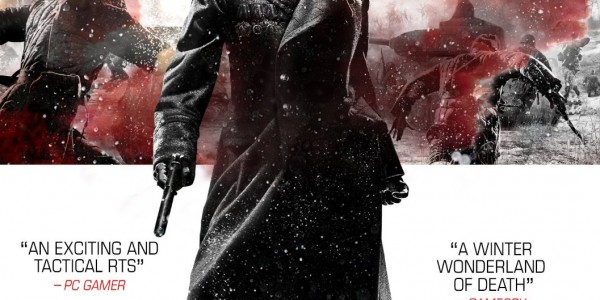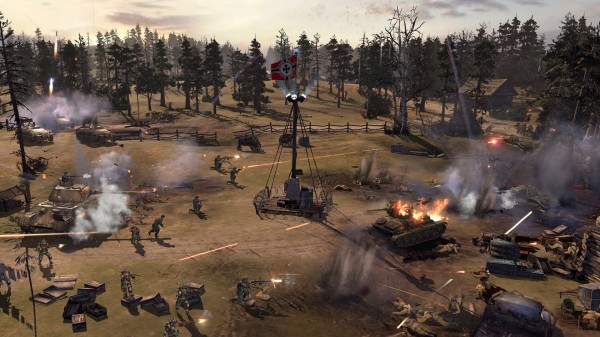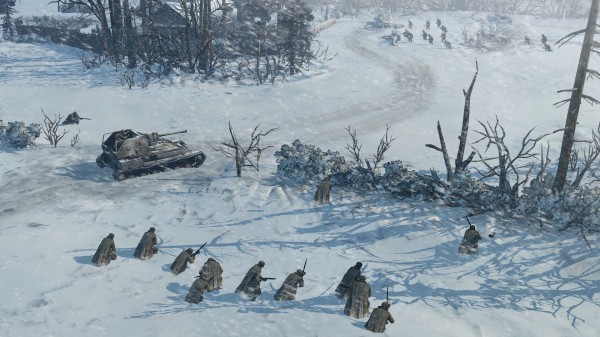Your boat arrives at the sandy shore, but what awaits for many is death. Every enemy is ready, guns at their side. The crashing of waves is drowned out by immense fire, bullets flying everywhere. What was once your best friend is now a blood-ridden corpse. But you and your comrades push forward with determination. Your infantry uses all the tricks up its sleeve – flanking from various directions, calling in artillery fire. What seems like days of fighting finally ends, and you are victorious.”
The above excerpt comes from a review I wrote seven years ago for Company of Heroes. The brilliant 2006 real-time strategy game managed to capture the chaos and tension of war with its fundamentally sound strategy mechanics and impressive visuals. Now it’s seven years later and the sequel has finally been released – I wish I could say that’s great news, but Company of Heroes 2 instills bittersweet feelings. On the one hand it effectively replicates the core foundation that made the original game such a success, but the familiarity also works against the sequel. This is a seven-year gap we’re talking about; I was hoping for meaningful change on some level. Instead, audiences are left with another solid RTS game, which is no longer remarkable in 2013.
The sense of time and place that the original Company of Heroes established so well came as a result of actually playing the game. The missions themselves and the tactics that went into successfully flanking enemy positions or destroying occupied buildings further engrossed players in the experience. This time around, developer Relic Entertainment opted to include a more prominent central narrative, highlighted by cutscenes in which a captured Soviet Army lieutenant converses with his old commanding officer and recalls his time in World War II. The game’s attempts at drama feel stilted, thus losing any emotional impact. This dissonance is reinforced by the mediocre voice acting in cutscenes, complete with silly accents. The emphasis on forced narrative ultimately lessens the impact of notable in-mission moments and represents a step backwards for the series.
Luckily, Company of Heroes 2 retains its predecessor’s excellent RTS design, which adheres to the theory of simplicity over complexity. Combat tactics are the real focus in the game, rather than managing resources and specific units. This is WWII we’re talking about, so prepare those battle tactics and get ready to flank enemies, stick to cover, and avoid the enemy’s line of sight. It does a wonderful job of immersing the player in the game and establishing the intensity of high-stakes battles throughout the entire campaign. The effect is undermined slightly by the fact that players can summon endless amounts of weak soldiers in an effort to take victory by sheer strength in numbers. It’s not an approach I used often and the potential for failure can be high, but its very presence may prove tempting for others and therefore weakens the otherwise great game mechanics.
Visuals also go a long way to create a memorable setting, and Company of Heroes 2 excels in this area, as well. The game’s technical prowess is a given, but the new weather system also looks fantastic and directly affects play during the actual missions. Some of the campaign takes place in winter conditions, complete with snow, icy surfaces, and deadly chills. Soldiers will need the comfort of fire or a warm building in order to avoid frostbite, and tanks don’t do so well on the delicacy of the icy ground. These missions create a synthesis of graphical and mechanical variety that proves to be the game’s most memorable quality.
Unfortunately the rest of Company of Heroes 2‘s single-player elements feel like they were pulled from an RTS checklist – various units that can be upgraded, a few missions that deviate from the core formula, standalone challenges, etc. On the plus side, some of those standalone challenges can be completed cooperatively, which ties into Company of Heroes 2‘s fun multiplayer package. The excellent RTS mechanics transition well into competitive battles, and the level of persistence and progression results in useful bonuses for units. I can absolutely see someone who loves the genre becoming invested in multiplayer competition.
All of this makes Company of Heroes 2 sound like a good game, and it’s just that: a good game. But as both a sequel and an RTS game, it doesn’t excel in key areas to help it stand out from the rest of the crowd. Instead, it feels like another expansion that happens to have more content and more multiplayer options than one might expect. A release like that is never worth a seven-year wait.




















